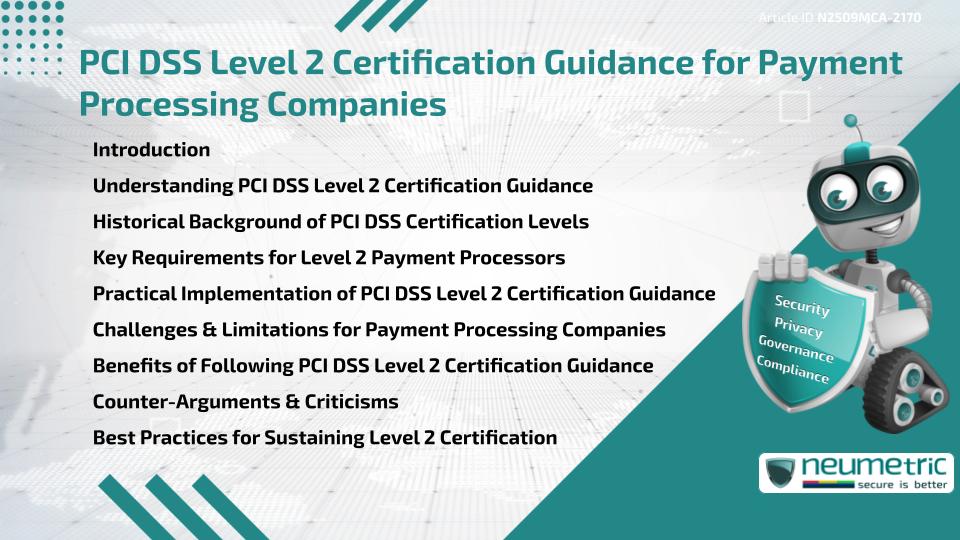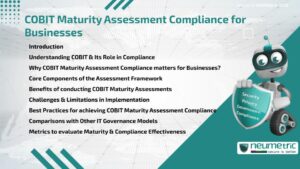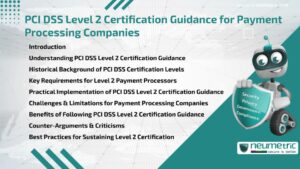Table of Contents
ToggleIntroduction
The Payment Card Industry Data Security Standard [PCI DSS] sets global requirements for Businesses handling Cardholder Data. Payment Processing Companies, given their role in securing Sensitive Transactions, must follow strict Compliance guidelines. The PCI DSS level 2 Certification guidance applies to Organisations that process between one million (1,000,000) and six million (6,000,000) Transactions Annually. It includes Annual Self-Assessment Questionnaires [SAQs], Quarterly Vulnerability Scans & in some cases, Audits by Qualified Security Assessors [QSAs]. This article explains the PCI DSS level 2 Certification guidance in detail, covering its background, requirements, practical implementation, challenges, benefits, criticisms & Best Practices for Payment Processing Companies.
Understanding PCI DSS Level 2 Certification Guidance
PCI DSS divides Merchants & Service Providers into Compliance levels based on Annual Transaction volumes. Level 2 applies to Companies processing more than one million (1,000,000) but fewer than six million (6,000,000) Transactions Annually. The PCI DSS level 2 Certification guidance requires Organisations to complete an Annual SAQ, undergo Quarterly Scans from an Approved Scanning Vendor [ASV], and in some cases submit a Report on Compliance [ROC] validated by a QSA. These measures ensure that Mid- to Large-sized Payment Processing Companies maintain a strong Security Posture.
Historical Background of PCI DSS Certification Levels
The PCI DSS Framework was introduced in 2004 by major Payment brands to unify Security Standards for Card Transactions. To accommodate different Business sizes, Certification levels were created. Level 2 was designed for Companies processing high Transaction volumes but not at the largest scale of Level 1 entities. Over time, Regulatory expectations & the role of QSAs have increased, making the PCI DSS level 2 Certification guidance more rigorous than in earlier years.
Key Requirements for Level 2 Payment Processors
The PCI DSS level 2 Certification guidance requires Payment Processors to:
- Complete an Annual SAQ covering all applicable PCI DSS requirements.
- Perform Quarterly Vulnerability Scans by an ASV.
- Implement Encryption & Tokenisation for Cardholder Data.
- Maintain secure Firewalls & regularly update Software.
- Restrict access to Cardholder Data based on Roles.
- Monitor & Log all access to Payment Systems.
- Establish Incident Response & Risk Management Procedures.
These requirements provide a structured Roadmap for achieving Compliance while reducing Risks of Fraud & Breaches.
Practical Implementation of PCI DSS Level 2 Certification Guidance
For Payment Processing Companies, practical implementation involves embedding Security Controls into daily operations. This includes securing Payment gateways, encrypting Transactions & segmenting Networks to isolate Sensitive Systems. Regular Employee Training ensures awareness of security protocols, while ongoing monitoring detects anomalies in real time. Many Companies also engage consultants or QSAs for support in preparing SAQs & conducting Readiness Assessments to avoid Compliance gaps.
Challenges & Limitations for Payment Processing Companies
While following the PCI DSS level 2 Certification guidance is essential, challenges remain. The cost of Compliance can be significant, particularly when upgrading Infrastructure or hiring External Consultants. Payment Processors with complex Networks face difficulties in scoping their Cardholder Data environments accurately. Another limitation is that Certification reflects Compliance at a point in time, not a guarantee of ongoing security. Additionally, some organisations view Compliance as a checklist exercise rather than an opportunity to strengthen long-term security.
Benefits of Following PCI DSS Level 2 Certification Guidance
Despite challenges, the PCI DSS level 2 Certification guidance offers substantial benefits. It reduces Fraud Risk, builds Customer & Partner Trust & enhances reputation. Achieving Level 2 Compliance also demonstrates Accountability to Regulators & Payment brands, helping avoid Penalties or Restrictions. Beyond Compliance, implementing the guidance strengthens Cybersecurity posture across the Organisation, making it more resilient against evolving Threats.
Counter-Arguments & Criticisms
Some critics argue that the PCI DSS level 2 Certification guidance creates unnecessary Financial & Administrative burdens, especially for Mid-sized Processors. Others believe that Compliance Audits & SAQs can foster a “check-the-box” mentality, where Companies prioritise passing Assessments over achieving meaningful Security improvements. Nevertheless, the structured Framework provides a consistent benchmark for securing Sensitive Payment Environments.
Best Practices for Sustaining Level 2 Certification
To sustain Level 2 Compliance effectively, Payment Processors should:
- Conduct Vulnerability Scans proactively rather than reactively.
- Regularly train Employees on Compliance & Security awareness.
- Automate Logging, Monitoring & Compliance reporting.
- Validate the Compliance of Third Party Vendors.
- Treat Certification as an ongoing process rather than an Annual event.
These practices help Companies not only achieve but also maintain strong Compliance over time.
Conclusion
The PCI DSS level 2 Certification guidance provides Payment Processing Companies with a structured approach to securing Cardholder Data. Although challenges such as cost & complexity exist, the benefits of reduced Fraud, stronger Customer Trust & Regulatory Accountability outweigh the difficulties. By integrating Compliance into everyday Operations & following Best Practices, Payment Processors can sustain Certification & enhance their Security resilience.
Takeaways
- PCI DSS Level 2 applies to Companies processing one million (1,000,000) to six million (6,000,000) Transactions Annually.
- The PCI DSS level 2 Certification guidance includes SAQs, Quarterly Scans & sometimes QSA-led Audits.
- Key requirements involve Encryption, Access Controls, Monitoring & Incident Response planning.
- Implementation requires secure Systems, Staff training & Vendor validation.
- Challenges include Costs, Scoping complexities & Audit fatigue.
- Benefits include reduced Fraud, enhanced Trust & Regulatory Accountability.
- Best Practices involve proactive scanning, automation, training & Continuous Monitoring.
FAQ
What is the PCI DSS level 2 Certification guidance?
It is the set of requirements for Companies processing between one million (1,000,000) to six million (6,000,000) Transactions Annually to validate PCI DSS Compliance.
Who must follow Level 2 Certification guidance?
Payment Processing Companies & other Entities falling within the Level 2 Transaction range must follow the guidance.
What Validation methods are required at Level 2?
Typically, an Annual SAQ & Quarterly ASV Scans are required, with some Companies needing QSA-led Audits depending on their Acquirer’s demands.
How does Level 2 differ from Level 1?
Level 1 requires an Annual onsite QSA Audit due to higher Transaction volumes, while Level 2 primarily uses SAQs with some QSA involvement.
What happens if a Level 2 processor is Non-Compliant?
Non-Compliance can lead to Penalties, increased Transaction Fees, Reputational harm & potential suspension of Card Processing Privileges.
Can Outsourcing Payment Services reduce Level 2 Compliance Scope?
Yes, Outsourcing can reduce scope, but Processors must ensure that Service Providers are themselves PCI DSS compliant.
Is PCI DSS Level 2 Certification a one-time requirement?
No, it requires ongoing monitoring, Quarterly Scans & Annual validation to maintain Compliance.
Need help for Security, Privacy, Governance & VAPT?
Neumetric provides organisations the necessary help to achieve their Cybersecurity, Compliance, Governance, Privacy, Certifications & Pentesting needs.
Organisations & Businesses, specifically those which provide SaaS & AI Solutions in the Fintech, BFSI & other regulated sectors, usually need a Cybersecurity Partner for meeting & maintaining the ongoing Security & Privacy needs & requirements of their Enterprise Clients & Privacy conscious Customers.
SOC 2, ISO 27001, ISO 42001, NIST, HIPAA, HECVAT, EU GDPR are some of the Frameworks that are served by Fusion – a SaaS, multimodular, multitenant, centralised, automated, Cybersecurity & Compliance Management system.
Neumetric also provides Expert Services for technical security which covers VAPT for Web Applications, APIs, iOS & Android Mobile Apps, Security Testing for AWS & other Cloud Environments & Cloud Infrastructure & other similar scopes.
Reach out to us by Email or filling out the Contact Form…





